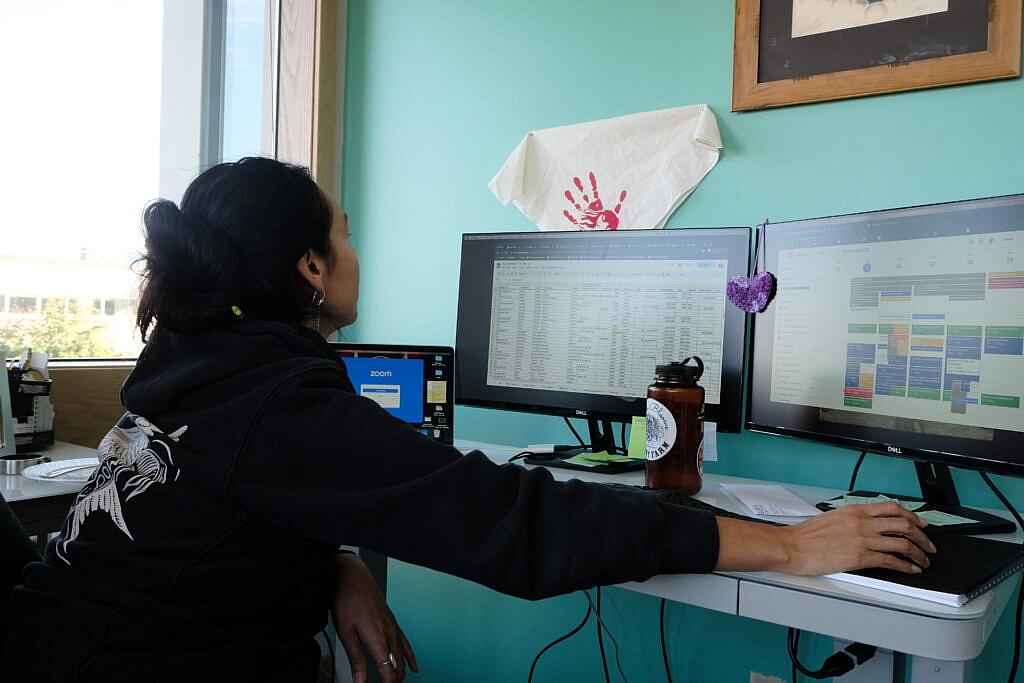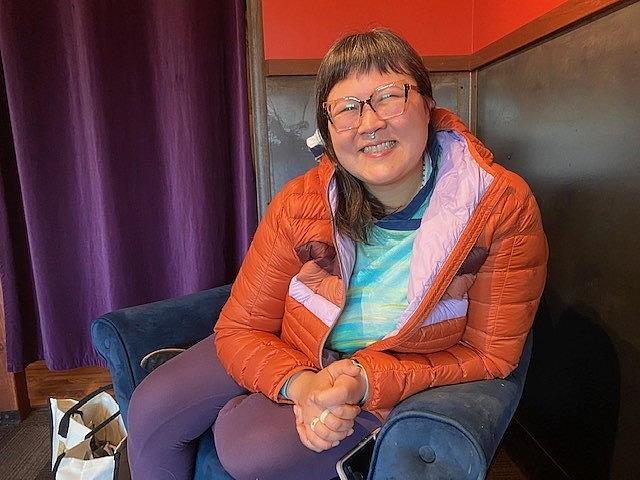Data links Alaska’s sky-high maternal mortality rate to domestic violence
The story was originally published by Alaska Beacon with support from our 2023 Domestic Violence Impact Fund.

Charlene Apok leads Data for Indigenous Justice and works with the state’s Maternal Child Death Review to understand maternal mortality in Alaska. Apok analyzed data in their office on Sept. 25, 2023.
Photo by Claire Stremple/Alaska Beacon
Charlene Apok sat in front of multiple computer monitors in an Anchorage office and scrolled through a spreadsheet of missing and murdered Indigenous Alaskans.
The neat boxes on the screen were labeled with things like name, date missing, location or cause of death, but Apok saw more — narrative lines of deep family love and loss, and a history of violence that dates back to colonization and boarding schools in Alaska.
“I can see patterns across these stories and experiences because I’ve lived them,” they said.
If you’ve been healthy enough to be pregnant, you shouldn’t be dying. It’s a time when protection and safety and health should be wrapped around a person. And the fact that violence is more common during that time is a serious problem.
– Ness Verigin, Maternal Child Death Review program manager
Apok runs Data for Indigenous Justice, a database of Missing and Murdered Indigenous People. The center has maintained this database since 2018; Apok says it’s for community and family.
“My mother passed away, and basically our family thinks she was murdered. And it was ruled suicide. It’s one of many of the statistics that we talk about. So I can read data and I can see the lived story and the experiences very easily,” they said.
Apok does not simply keep the data, but aims to humanize it. And the mothers on the list are why Apok is working with a state program, the Maternal Child Death Review, to help understand and prevent the deaths that happen in the time between delivery and the first year of motherhood.
A basic fact driving these numbers is startling: More Alaskans who die in the first year after delivering a baby do so as a result of violence or overdose, rather than from medical causes. Alaska Native people are disproportionately represented. The most recent data shows that nearly twice as many pregnancy-associated deaths in the state are from homicide, suicide and drug or alcohol overdose than are from pregnancy-related medical causes. More than 70% of the mothers who died had a history of intimate partner violence.
State researchers say the data shows that trauma and intimate partner violence are killing Alaska mothers. So as state health employees and birth workers fight to keep mothers from dying, they aren’t just fighting for increased access to medical care. They’re fighting to increase access to safety.
Crisis of underlying trauma
Ness Verigin, who manages the Maternal Child Death Review, said the state has begun to address maternal mortality from violence, but there’s a lot of room for more prevention efforts.
“If you’ve been healthy enough to be pregnant, you shouldn’t be dying,” they said. “It’s a time when protection and safety and health should be wrapped around a person. And the fact that violence is more common during that time is a serious problem.”
Apok added that when people go through a long history of domestic violence or sexual assault and then overdose or attempt suicide, those deaths need to be understood as part of that violence.
“How we translate those stories and those impacts and those connections in a way where we can improve prevention and services is a huge challenge,” Apok said. “So many of those things are stigmatized, especially for certain races or ethnicities.”
Studies show that pregnant people who are abused can turn to suicide to end the abuse. Like Apok, Verigin also said deaths from overdose of drugs or alcohol are also usually responses to violence.
“Women, especially pregnant women, just don’t use substances because they’re partying or they’re having fun or they’re just irresponsible people,” Verigin said, adding that direct treatment providers with substance use programs say that most of their clients have experienced intimate partner or sexual violence in their lifetimes. “There’s usually something really serious wrong. And often it’s being victimized and having their power taken away. And it’s a way of numbing the pain and surviving.”
A lot of these women are not getting the medical care they need because they or their children are unsafe or they are just unable to go to the hospital. And you see that more than you would think you would.
– Jennifer Harlos, nurse at Alaska Native Tribal Health Center
Health care professionals screen for domestic violence, and Verigin said medical settings can be a place where pregnant people are away from their perpetrator and can talk about their experiences.
The state’s new postpartum Medicaid expansion law allows new parents to get health care benefits up to 12 months after giving birth.
“The extension of Medicaid postpartum is so, so important, because it gives more opportunities to engage in care where these kinds of things can be identified,” Verigin said. “That postpartum period is such a stressful time that if there’s going to be violence in that relationship, it’s more likely to come out during that time.”
Jennifer Harlos, a nurse and a member of the committee overseeing the Maternal Child Death Review, said seeing the nonmedical issues that affect medical care propelled her to pursue graduate study in public health. She has worked at the Alaska Native Tribal Health Consortium for 12 years, mostly in labor and delivery.
“You’re at the bedside in this vulnerable moment in someone’s life. And you see all of these issues, but there’s only so much you can do from that lens in that moment,” she said, referring to things like intimate partner violence. “If you talk to me or any of my colleagues, we all know what the problems are. We see the problems and we can’t necessarily fix them from our seat in the hospital.”
Domestic violence affects maternal mortality in homicides and suicides, but it can even contribute to the deaths from medical causes.
“If you aren’t allowed to leave the house, then you’re not going to go to your appointment. And if you know that your partner is going to drink and hurt your children, then you’re not going to get admitted to the hospital,” Harlos said.
“People don’t think about that. But a lot of these women are not getting the medical care they need because they or their children are unsafe or they are just unable to go to the hospital. And you see that more than you would think you would.”
Those stakes are especially high for the women who must travel for medical care.
Harlos said a pregnant person who experiences domestic violence is more likely to experience several conditions that can increase risk. They are more likely to go into preterm labor, to have an abruption — when the placenta detaches from the womb as a result of abdominal trauma, high blood pressure or substance use — and to have intrauterine growth restriction because of physical and emotional stress.
“The majority of our deaths are Alaska Native women. And many of them are happening in rural Alaska where they have some of the worst access to these services,” she said.
Family by family
Harlos said the barriers to access are are part of why the most common recommendation from the Maternal Child Death Review Board is that the state expand home visiting nurse programs across Alaska.
“These women, whether it’s for intimate partner violence or for a plethora of reasons, are not seeking care, right? And so we need to go to them and bring that care. And that’s what these programs do,” she said.
Home nurse visiting programs already exist in Alaska, but not every pregnant Alaskan has access to them. The Maternal Child Death Review began a partnership with an Alaska Native birth worker program for culturally responsive support with a $250,000 a year grant from the Office on Women’s Health. The state has three more years of grant funding and is transitioning that program to a partnership with the university system, Verigin said.
Harlos said the birth worker or doula is a connection between the home and family life and the medical world — they understand the needs and limitations of people who work in health care and they have an understanding of the home life and personal concerns of the patient. They can use that knowledge to advocate for their patient.
“They’re very familiar with what things are like at the hospital, but then they also know situations that are going on for our patients that we don’t know about,” she said.
“And so there’s that culturally managed care that they don’t always get from everybody in their health care team,” Harlos said. “That goes a long way in building trust when you think about historical trauma and things that have happened.”
Abra Patkotak is a birth worker who visits pregnant people in their homes before, during and after pregnancy. She, along with Charlene Apok from Data for Indigenous Justice, is a member of the Alaska Native Birth Workers Collective, which provides care without charge to Alaska Native families. Currently, the collective is crowd-funded, Patkotak said.
The collective started as an idea in a group text thread, but has grown. By Apok’s count, the group has certified more than 40 doulas and lactation consultants. The group also teaches childbirth education classes and facilitates mens’ groups.
“The lack of support is huge,” Patkotak said.
She links the violence to a system that is failing to support Alaska Native families, especially families that live far enough from major hospitals that pregnant people must leave their home communities a month before delivery to be near a hospital, which is common practice for most remote Alaska communities.

Abra Patkotak sat in Anchorage on her way to a Kansas City March for Moms event on Sept. 28, 2023.
Photo by Claire Stremple/Alaska Beacon
“For Alaska Native people, if you’re from rural Alaska, the additional stress of having to leave your community, often at 35 weeks or earlier, leave your support system and often having to leave your other children behind — the stress that that creates for our families is huge. And it’s not been studied, but there’s nowhere else in the United States that this forced evacuation is happening,” Patkotak said.
She said most medical providers are not Alaska Native, have never been to rural Alaska and can’t quite grasp what these families are going through just to get to the hospital.
“Navigating the health care system when you’re alone can feel very overwhelming,” she said. “Who you encounter with the health care system may not necessarily understand your culture, your beliefs, even your body language … Culturally understanding how to communicate with people — even without words — that’s a huge thing, to create safety, especially during birth.”
Patkotak said she and other birth workers can help pregnant people get the care they need in medical spaces, but also help them stay safe because their work can diffuse tension and anxiety in the home.
“If someone’s not in a good situation, and we’ve already built that trust and we’ve created safety, so they know they can trust us, then people can reach out and we are able to connect people to resources that they might not otherwise know about if they need help,” she said.
Apok and Patkotak said the disproportionate number of Alaska Native families that are affected by domestic violence is a trend that can be stigmatizing if people do not understand the historical context.
“This is directly from colonization,” Apok said. “Living elders today are sharing about what happened in boarding schools. It’s horrific . . . Men didn’t just become violent. It happened because that was what was taught and their experience. We have children as young as 5 and 4 who were taken and then abused, and then had to raise families. What did we expect was going to happen?”
“It was something that was pushed on us that we are now actively fighting to recover from,” Patkotak said. “We’re not violent people, but we have been deeply hurt by systems that are unsafe.”
Ultimately, they say that childbirth education and direct work to build healthier families is helping to rebuild and heal that history. Apok said that, despite the grim data they work with, and the violence that continues statewide, there’s hope.
“I truly believe that’s making a huge difference,” they said.
“Family by family, you know?”

